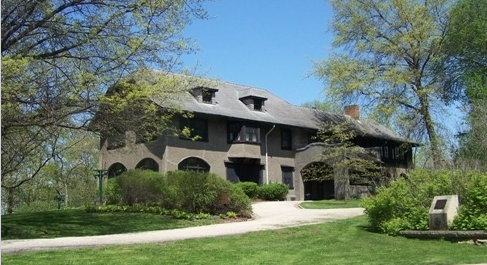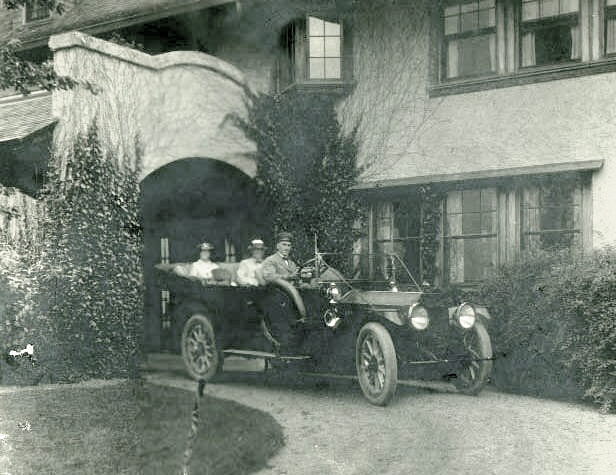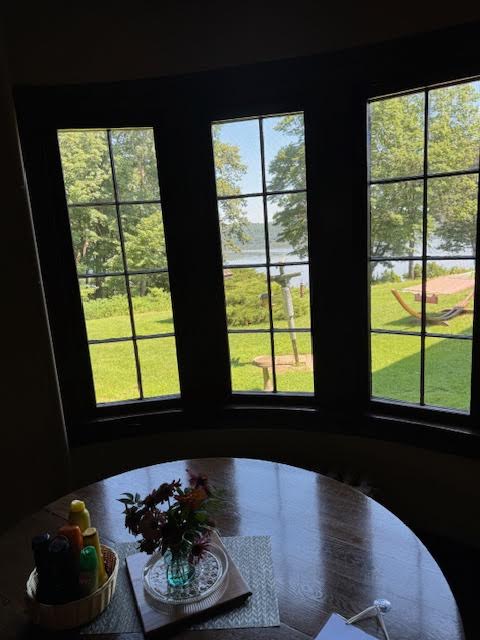Encyclopedia Dubuque
"Encyclopedia Dubuque is the online authority for all things Dubuque, written by the people who know the city best.”
Marshall Cohen—researcher and producer, CNN
Affiliated with the Local History Network of the State Historical Society of Iowa, and the Iowa Museum Association.
FOUR MOUNDS: Difference between revisions
No edit summary |
No edit summary |
||
| (27 intermediate revisions by 2 users not shown) | |||
| Line 1: | Line 1: | ||
[[Image:fourmounds.gif| | [[Image:fourmounds.gif|right|thumb|150px|Four Mounds remains one of the most fascinating estates in Dubuque.]] | ||
[[Image:greyhouse.png|left|thumb|250px|]]FOUR MOUNDS. [[BURDEN, George A.|George A. BURDEN]] moved to Dubuque in 1857. He married Viola Rider and together in 1908 they moved to Four Mounds--named for burials by the [[MOUND BUILDERS]] in a nearby woods. (1) The estate consisted of about 60 acres of bluff-land along the [[MISSISSIPPI RIVER]], comprised of cultured grounds, historic gardens, woodlands, prairie and a rare oak savanna. The 17 buildings on the estate are residential, farm, recreational and support structures. (2) | |||
[[Image:burdens.jpg|left|thumb|250px|The Burdens in a car at the Grey House. Photo courtesy: Chris Olson.]] | |||
The site is focused around the historic Grey House, a 1908 [[ARTS AND CRAFTS ARCHITECTURE]] mansion designed by the Chicago architect, Lawrence Buck. The grounds were planned out by Chicago landscape architect, A. Phelps Wyman. Many buildings on the estate's farm campus were built between 1908 and 1911, including the barn/garage, chauffeur’s house, gardener's house and the root cellar. [[BURDEN, George A.|George A. BURDEN]] and his wife Viola developed this gentleman's farm in the country outside Dubuque in order to raise their children. The Burdens were able to enjoy a country lifestyle, with downtown Dubuque accessible through the use of their automobile, allowing Mr. Burden to commute to work on a daily basis. (3) | |||
George R. Burden, better known as "Bill," contracted polio at the age of fourteen. George A. Buden had the gentlemen's farm, one of the last in Iowa, constructed Bill. The farm produced no goods for sale. The flower and vegetable gardens, beef, and dairy cattle were for the family use only. The White House on the grounds of the estate was constructed for "Bill" Burden and his wife Elizabeth. (4) Playhouses and a small swimming pool for the children were built alongside it. A beautiful rock garden and potting shed was tended by Elizabeth. A wood shop for Bill were also built immediately nearby. (5) | |||
[[Image:carriage.png|right|thumb|250px|This baby carriage was used by the Burdens and carried the name Geo. Burden. For its history see: [[BURDEN BABY CARRIAGE]] ]] George R. Burden had married Elizabeth Adams, the daughter of [[ADAMS, John Taylor|John Taylor ADAMS]] in 1924. The architect of the White House is unknown, but it is in a traditional Colonial Revival style and always featured its signature white clapboards, columns and interior trim. The Burdens raised their three girls, Frindy, Vidie and Betsy, in this house. The address--White House, Four Mounds Estate, 4900 Peru Road-- was occupied from 1925 to Mrs. Burden’s death in 1982, when the 60 acre estate was bequeathed to the City of Dubuque in order that it be made available to the public for educational uses. (6) | |||
The Burdens would not have been able to maintain Four Mounds without the help of dedicated, long-term employees. At the time of Elizabeth's death in 1982, she still had full-time, live-in staff. These people worked hard and were looked on as part of the Four Mounds family. The Heitzmans (gardeners and caretakers) lived in the lower yellow house (or Gardener's House) for six decades. Milton Kirch, the chauffeur, lived in and worked out of the upper yellow house (Chauffeur’s House) for over thirty years. Mildred or “Mo” Hahlen supervised the White House and was the cook to Bill Burden’s family for over 50 years. The Burden children said she was like a second mother to them. Hannah Driscoll played the same role at the Grey House for over 40 years. | |||
The Foundation | [[Image:riverview.jpeg|left|thumb|250px|River view of the Mississippi from the living room of the Grey House.]] | ||
[[Image:livingroom.jpeg|left|thumb|350px|Living room and three-season room of the Grey House.]]The site is owned by the City of Dubuque while the Four Mounds Foundation is entirely responsible for its management and fundraising. Four Mounds Foundation was founded as a non-profit organization in 1987 as a means to preserve the historic Four Mounds estate and make it available to the public for a variety of educational uses. A rehabilitation project started in the late 1990s was completed in December of 2011. The pipes in the house had broken over the years and severe damage had taken place. The plaster work were restored, the mechanical portions were all updated, air conditioning was installed, lead paint was removed, the cedar roof was replaced, and the windows were restored. With the exception of replacing one of the children’s bathrooms with an adult bathroom, no interior changes were made. Some non-historic windows on the second floor porch were re-created to the original design. (7) With the conclusion of the White House restoration, the building was opened to the public for the first time in its history. | |||
The Four Mounds Estate is listed on the City of Dubuque historic register as a Local Landmark as well as on the [[NATIONAL REGISTER OF HISTORIC PLACES]]. Contemporary uses of the estate include being open 365 days a year as a city park, hiking trails overlooking the Mississippi River, and a Challenge Ropes Course. The main buildings are operated as an Inn & Conference Center. The Four Mounds Foundation has a mission and history of using the site to benefit youth, the community and at-risk populations. (8) | |||
In November, 2018 the announcement was made that Four Mounds had obtained state funding to return the site to its natural oak savanna landscape. It was hoped that such a project would slow soil erosion, open access to more visitors, and increase biodiversity. The $200,000 grant would enable removal of invasive species and those, like the maple, that discourage the oak savanna. The change from savanna to the current woods began with European settlement, the introduction of exotic seeds, fire suppression and overgrazing. (9) | |||
See: [[CITY LANDMARKS]] | |||
--- | |||
Source: | |||
1. Schmidt, Michael. "Four Mounds A Country Estate in the City," ''Telegraph Herald'', November 10, 2008, p. 28 | |||
2. "10th Annual Ken Kringle Historic Preservation Awards Announced," News Release, City of Dubuque, Online: http://www.cityofdubuque.org/ArchiveCenter/ViewFile/Item/2759 | |||
3. Ibid. | |||
4. Schmidt | |||
5. "10th Annual..." | |||
6. Ibid. | |||
7. Ibid. | |||
8. Ibid. | |||
9. Fisher, Benjamin, "Four Mounds Eyes Return to Natural Beauty," ''Telegraph Herald'', Oct. 28, 2018, p. 17A | |||
Four Mounds: http://www.fourmounds.org/. | |||
"Four Mounds Estate," http://weblink.cityofdubuque.org/WebLink8/1/doc/28651/Page26.aspx | |||
[[Category: Buildings]] | [[Category: Buildings]] | ||
[[Category: Landmarks | [[Category: Landmarks]] | ||
Latest revision as of 19:55, 28 July 2025
FOUR MOUNDS. George A. BURDEN moved to Dubuque in 1857. He married Viola Rider and together in 1908 they moved to Four Mounds--named for burials by the MOUND BUILDERS in a nearby woods. (1) The estate consisted of about 60 acres of bluff-land along the MISSISSIPPI RIVER, comprised of cultured grounds, historic gardens, woodlands, prairie and a rare oak savanna. The 17 buildings on the estate are residential, farm, recreational and support structures. (2)
The site is focused around the historic Grey House, a 1908 ARTS AND CRAFTS ARCHITECTURE mansion designed by the Chicago architect, Lawrence Buck. The grounds were planned out by Chicago landscape architect, A. Phelps Wyman. Many buildings on the estate's farm campus were built between 1908 and 1911, including the barn/garage, chauffeur’s house, gardener's house and the root cellar. George A. BURDEN and his wife Viola developed this gentleman's farm in the country outside Dubuque in order to raise their children. The Burdens were able to enjoy a country lifestyle, with downtown Dubuque accessible through the use of their automobile, allowing Mr. Burden to commute to work on a daily basis. (3)
George R. Burden, better known as "Bill," contracted polio at the age of fourteen. George A. Buden had the gentlemen's farm, one of the last in Iowa, constructed Bill. The farm produced no goods for sale. The flower and vegetable gardens, beef, and dairy cattle were for the family use only. The White House on the grounds of the estate was constructed for "Bill" Burden and his wife Elizabeth. (4) Playhouses and a small swimming pool for the children were built alongside it. A beautiful rock garden and potting shed was tended by Elizabeth. A wood shop for Bill were also built immediately nearby. (5)

George R. Burden had married Elizabeth Adams, the daughter of John Taylor ADAMS in 1924. The architect of the White House is unknown, but it is in a traditional Colonial Revival style and always featured its signature white clapboards, columns and interior trim. The Burdens raised their three girls, Frindy, Vidie and Betsy, in this house. The address--White House, Four Mounds Estate, 4900 Peru Road-- was occupied from 1925 to Mrs. Burden’s death in 1982, when the 60 acre estate was bequeathed to the City of Dubuque in order that it be made available to the public for educational uses. (6)
The Burdens would not have been able to maintain Four Mounds without the help of dedicated, long-term employees. At the time of Elizabeth's death in 1982, she still had full-time, live-in staff. These people worked hard and were looked on as part of the Four Mounds family. The Heitzmans (gardeners and caretakers) lived in the lower yellow house (or Gardener's House) for six decades. Milton Kirch, the chauffeur, lived in and worked out of the upper yellow house (Chauffeur’s House) for over thirty years. Mildred or “Mo” Hahlen supervised the White House and was the cook to Bill Burden’s family for over 50 years. The Burden children said she was like a second mother to them. Hannah Driscoll played the same role at the Grey House for over 40 years.
The site is owned by the City of Dubuque while the Four Mounds Foundation is entirely responsible for its management and fundraising. Four Mounds Foundation was founded as a non-profit organization in 1987 as a means to preserve the historic Four Mounds estate and make it available to the public for a variety of educational uses. A rehabilitation project started in the late 1990s was completed in December of 2011. The pipes in the house had broken over the years and severe damage had taken place. The plaster work were restored, the mechanical portions were all updated, air conditioning was installed, lead paint was removed, the cedar roof was replaced, and the windows were restored. With the exception of replacing one of the children’s bathrooms with an adult bathroom, no interior changes were made. Some non-historic windows on the second floor porch were re-created to the original design. (7) With the conclusion of the White House restoration, the building was opened to the public for the first time in its history.
The Four Mounds Estate is listed on the City of Dubuque historic register as a Local Landmark as well as on the NATIONAL REGISTER OF HISTORIC PLACES. Contemporary uses of the estate include being open 365 days a year as a city park, hiking trails overlooking the Mississippi River, and a Challenge Ropes Course. The main buildings are operated as an Inn & Conference Center. The Four Mounds Foundation has a mission and history of using the site to benefit youth, the community and at-risk populations. (8)
In November, 2018 the announcement was made that Four Mounds had obtained state funding to return the site to its natural oak savanna landscape. It was hoped that such a project would slow soil erosion, open access to more visitors, and increase biodiversity. The $200,000 grant would enable removal of invasive species and those, like the maple, that discourage the oak savanna. The change from savanna to the current woods began with European settlement, the introduction of exotic seeds, fire suppression and overgrazing. (9)
See: CITY LANDMARKS
---
Source:
1. Schmidt, Michael. "Four Mounds A Country Estate in the City," Telegraph Herald, November 10, 2008, p. 28
2. "10th Annual Ken Kringle Historic Preservation Awards Announced," News Release, City of Dubuque, Online: http://www.cityofdubuque.org/ArchiveCenter/ViewFile/Item/2759
3. Ibid.
4. Schmidt
5. "10th Annual..."
6. Ibid.
7. Ibid.
8. Ibid.
9. Fisher, Benjamin, "Four Mounds Eyes Return to Natural Beauty," Telegraph Herald, Oct. 28, 2018, p. 17A
Four Mounds: http://www.fourmounds.org/.
"Four Mounds Estate," http://weblink.cityofdubuque.org/WebLink8/1/doc/28651/Page26.aspx






